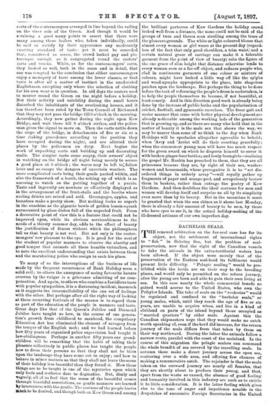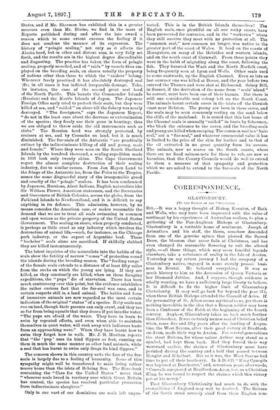BACHELOR SEALS.
THE renewed arbitration on the fur-seal case has for its: object, not the settlement of international rights to " fish " in Behring Sea, but the problem of seal.. preservation, now that the right of the Canadian vessels to take the animals in the extra-territorial waters has been allowed. If the object were merely that of the preservation of the Eastern seal-herd its fulfilment would present little difficulty. "Pelagic sealing" would be pro- hibited while the herds are on their way to the breeding places, and would only be permitted on the return journey, after the young are born and able to gain their own living at sea. In this case nearly the whole commercial benefit so- gained would accrue to the United States, who own the Pribylov Islands. The take of seals on the "rookeries" would be regulated and confined to the "bachelor seals," or young males, which, until they reach the age of five or sir years, are -unable to acquire wives, and live in a kind of clubland on parts of the island beyond those occupied as "married quarters" by older seals. Against this the Canadian shipmasters urge that they would make no catch worth speaking of, even if the herd did increase, for the return journey of the seals differs from that taken by them on their way northward. During the latter the animals follow a narrow route, parallel with the coast of the mainland. In the course of this migration the pelagic sealers can command the whole breadth of sea covered by the travelling seals. In autumn these make a direct journey across the open sea,. scattering over a wide area, and offering few chances of making a remunerative catch. The rejoinder is that the seals. taken on the outward journey are nearly all females, that. they are shortly about to produce their young, and that, apart from the waste so caused, the absence of good feeling- and humanity involved in this industry are such as to entitle it to little consideration. It is the latter feeling which gives. rise to the tone of anger and impatience notable in the despatches of successive Foreign Secretaries in the United
States, and if Mr. Sherman has exhibited this in a greater measure even than Mr. Blaine, we find in the mass of Reports published during and after the late award a reason which to some extent excuses the feeling if it does not condone the manner of its expression. The history of "pelagic sealing," not only as it affects the Alaska herd, but in other and distant seas, is very fully set forth, and the results are in the highest degree discreditable and disgusting. The practice has taken the form of pelagic sealing, properly so-called, and of " raids " by vessels thus em- ployed on the breeding seals, on shores usually the property of nations other than those to which the " raiders " belong. Wherever freely practised it has absolutely destroyed seal life; in all cases it has inflicted irreparable damage. Take, lor instance, the case of the second great seal herd (A the North Pacific. This haunts the Commander Islands 4Russian) and the Kurile Islands of Japan. The Japanese Foreign Office early tried to protect their seals, but they were killed at sea, and " raided " on shore till the fishery was nearly destroyed. "The foreigners," says the Japanese Report, ' do not in the least care about the decrease or extermination of the species ; they freely use their guns in hunting; thus we are obliged to throw aside the old instruments such as clubs." The Russian herd was strongly protected, by cruisers at sea, and by Cossacks on land, but it is much diminished. The fur-seals of the Antarctic "are practically extinct by the indiscriminate killing of old and young, male and female." Where they were seen on the South Shetland Islands by the hundred thousand, a sealing expedition made in 1891 took only twenty skins. The Cape Government regret the almost complete destruction of their sealing industry, due to similar causes. From Jan Mayen Land to the fringe of the Antarctic ice, from the Poles to the Tropics, aomes the same disgraceful story of the irresponsible greed and cruelty of the "pelagic" sealers. It has been condemned by Japanese, Russians, Aleut Indians, English naturalists like Sir William Flower, American statesmen, and the Secretaries and Governors of British Colonies, across the globe, from the Falkland Islands to Newfoundland, and it is difficult to say anything in its defence. This admission, however, by no means concedes the American case, or makes reasonable the demand that we are to treat all seals swimming in common and open waters as the private property of the United States Government. The sealing on shore, when properly conducted, is perhaps as little cruel as any industry which involves the destruction of animal life,—such, for instance, as the Chicago pork industry, or the export of Argentine beef. These " bachelor" seals alone are sacrificed. If skilfully clubbed they are killed instantaneously.
The latest inquiries of the naturalists into the habits of the seals show the futility of narrow "zones" of protection round the islands during the breeding season. The "feeding range" of the female seals extends to a distance of at least fifty miles from the rocks on which the young are lying. If they are killed, as they constantly are killed, when on these foraging expeditions, the " pups " die of starvation. There has been much controversy over this point, but the evidence establishes the rather curious fact that the fur-seal was once, and in certain respects still is, a land animal. The habits and form of immature animals are now regarded as the most certain indication of the original " status " of a species. Baby seals can run on land, though their parents can only crawl, and they are so far from being aquatic that they drown if put into the water. "The pups are afraid of the water. They have to learn to swim by repeated efforts, and even when able to maintain themselves in quiet water, will rush away with ludicrous haste from an approaching wave." When they have learnt how to swim they forget how to walk. Mr. J. H. Moulton reports that "the ' pup ' uses its hind flippers as feet, running on them in much the same manner as other land animals, while a seal that has learnt to swim only drags its hind flippers."
The concern shown in this country as to the fate of the fur. sealsis largely due to a feeling of humanity. Some of this sympathy might well be transferred to seals living rather nearer home than the islets of Bchring Sea. The Blue .book containing the "Case for the United States" notes that "wherever seals breed in territory over which Great Britain has control, the species has received particular protection from indiscriminate slaughter."
Only in one Part of our dominions are seals left unpro-
tected. This is in the British Islands themselves ! The English seals, once plentiful on all our rocky coasts, have
been persecuted for centuries, and in the " rookeries " when they still survive they meet with no protection at all. The "common seal," now common no longer, was native to the greater part of the coast of Wales. It bred on the coasts of Morayshire, on many of the Hebrides and western islands, and on the south coast of Cornwall From these points they were in the habit of migrating along the coast, following the fish. They haunted the Wash and the North Norfolk coast, being frequently seen at Lynn and Wells. Other seals used to come eastwards, up the English Channel. Even so late as last summer one was killed at Dover, and the year before two entered the Thames and were shot at Richmond. Selsey Bill, in Sussex, if the derivation of the name from "seals' island" be correct, must have been one of their haunts. But there is still one considerable seal colony left on the South Coast. The animals haunt certain caves in the islets off the Cornish coast near Helston. The young are born in these caves, and the seals may be seen commonly resting on the sand below the cliffs of the mainland. It is stated that this last home of the Channel seals is annually "raided" in boats by fishermen, who block the entrance to the caves, and the breeding-seals and young are killed when escaping. The common seal is a hair. seal," not a "fur-seal," and whatever commercial value it has is limited to the price of the skin for leather and to that of the oil extracted in no great quantity from its carcase. The animals, now so scarce on the South coasts, where there are no fixed salmon-nets for them to rob, are now so harmless, that the County Councils would do well to extend to them a measure of that sympathy and protection which we are asked to extend to the fur-seals of the North Pacific.



































 Previous page
Previous page